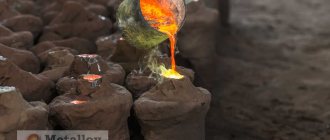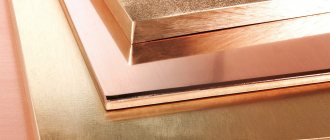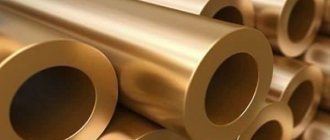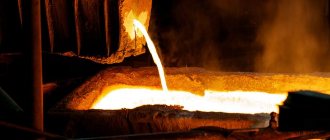Patination of copper, as well as other methods of its decorative processing (including at home), can make products made from this metal more attractive and give them a touch of noble antiquity. Items made not only from copper, but also from its alloys such as bronze and brass can be subjected to this treatment.
Using various methods of patination of copper alloys, you can achieve completely different shades
Patination and oxidation
The surface of many metals (and copper is one of them), when interacting with the surrounding air and various chemicals, begins to become covered with a thin layer of oxides and oxides. This process, which also leads to a change in the color of the metal surface, is called oxidation. For the most part, the process of metal oxidation occurs naturally, but people have learned to cause it artificially, in industrial or home conditions, which is done to give the product an aged look.
Oxidation should not be confused with patination, a process whose essence lies in the fact that a thin layer of sulfur or chloride compounds is formed on the surface of the metal when interacting with various chemical elements. Patination, which, like oxidation, is accompanied by a change in the color of copper and bronze, can also be performed artificially using special compounds.
Copper aging occurs naturally over time or immediately when the surface is treated with any preparations.
If under natural conditions the process of oxidation and patination of copper or bronze can take years, then when using special solutions, patination occurs in a very short period of time. The surface of a product placed in such a solution literally changes its color before our eyes, acquiring a touch of noble antiquity. Using various chemical compositions, you can perform such procedures as blackening of copper, patination of objects made of copper and bronze, and blackening of brass in production and even at home.
For several centuries now, artistic bronze has remained one of the main materials for making a wide variety of “plastics”: office and home decorations, souvenirs and much more. A special place in the production of bronze products of any scale is occupied by the patination process. This technique is especially often used by craftsmen when creating small sculptures.
In the 18th century, bronze accessories became the main decorative element of palace interiors in Russia. Sculptures, candelabra, lamps in combination with natural stone and glass took a dominant position in the interior of the royal residences. The fashion for bronze jewelry also spread among the nobility. Thus, historians call the 18th and early 19th centuries the time of dominance of artistic bronze products.
With the development of artistic crafts, new technologies and production methods began to appear, which required, in particular, the reorganization of the process itself. Bronze products of Russian craftsmen became increasingly popular for their richness and unusual decorative design. The masters complemented the superbly executed casting with embossing, gilding, and in the mid-19th century, bronze patination also joined these processes.
Products made from patinated bronze immediately fell in love with consumers for their unusual appearance: a noble shade and the so-called “patina” of antiquity. The use of patination allowed domestic craftsmen to enter the foreign market and, in particular, to successfully compete with leading European manufacturers.
In a broad sense, patina is a kind of film formed on the surface of a bronze product during the oxidation of the metal. One method of patination of bronze items involves heating and using nitric acid. It is worth noting that patina is divided into artificial and natural. Artificial patina is formed after special manipulations with acid, and natural patina is formed as a result of prolonged exposure to the environment (rain, snow, wind, temperature changes).
Products made from patinated bronze are distinguished by an unusual shade (from golden to greenish). It is almost impossible to confuse a work covered with patina with an ordinary bronze product. Experience the beauty of patinated bronze accessories now. The collection of the Russian gift house “Great Rus'” contains a wide variety of bronze items with patina: from small to massive plastic. Each work is distinguished by the highest quality and original design.
Preparation for processing
Having decided to perform patination or oxidation, you should not only carefully study the question of how to age brass, bronze or blacken copper, but also provide the necessary safety measures. The vast majority of chemical compounds that are used to carry out such procedures are very toxic and emit vapors that pose a significant danger to human health. Therefore, to store such substances both in industrial and at home conditions, you should use vessels with well-ground stoppers, which will prevent toxic vapors from entering the surrounding air.
Keep chemicals out of the reach of children
The procedure itself, carried out to change the color of the surface of a product under the influence of chemicals on it, should be performed in a special cabinet to which exhaust ventilation is connected. It should be borne in mind that the doors of such a cabinet should be slightly open during the process of oxidation or patination, which will ensure effective extraction of harmful vapors from its interior.
Products made of copper, brass and bronze should be thoroughly cleaned, degreased and washed in warm water before patination. After the patination or oxidation procedure itself, the treated objects are also washed and placed in sawdust to dry. Using sawdust is a more gentle drying method, since performing such a procedure with a fabric material can damage the thin film of the formed patina, which has not yet been fixed with varnish. In addition, using fabric after patination, it is almost impossible to efficiently remove moisture from the recesses on relief surfaces, and sawdust can easily be pulled out.
The varnished surface can be polished with a felt pad.
The difference between brass and bronze
In order to distinguish brass from bronze, you need to know the features of their structure:
- bronze contains: copper, aluminum, tin, silicon;
- The brass alloy contains copper, zinc, beryllium and lead.
It is precisely because of the presence of copper in both metals that it is difficult to distinguish them. But due to the presence of other different chemical elements, bronze and brass differ from each other both in properties and structure, and in durability. Items made from these alloys can also be distinguished by their appearance: items made from brass are more yellow than items made from bronze, which have a dark brown color .
Changes in color of copper and its alloys from gray to black
The grey, dark gray or black color of copper and its alloys makes the appearance of the product more attractive and presentable. To obtain these colors, the degree of saturation of which can be adjusted, you need the “liver of sulfur” composition that has been used for decades. It got its name due to the fact that during the cooking process it must sinter, that is, turn into a caked mass.
To make such a composition for patination at home, you must perform the following steps:
- one part of powdered sulfur is mixed with two parts of potash;
- the resulting mixture is placed in a tin can, which then must be put on fire;
- After waiting for the powder to melt and start sintering, it is necessary to maintain this process for 15 minutes.
To prepare sulfur liver you will need soda and sulfur
During the sintering process of the powder, a blue-green flame may flare up on its surface, which does not need to be knocked down, since it will not deteriorate the quality characteristics of the sulfur liver. After sintering is completed and completely cooled, the resulting mass should be crushed to a powder state. This powder, if placed in a glass jar with a tight-fitting lid, can be stored for a long time.
In order to patina various metal alloys using liver sulfur, several basic methods are used.
Method No. 1
This method involves the use of an aqueous solution of sulfur liver. It can be used to change the color of products made from the following materials:
- copper;
- sterling silver;
- bronze and brass.
The colors that can be used to paint the surfaces of products using this method also vary:
- copper and silver - purple, blue (very difficult to obtain), gray, brown-gray, black;
- brass and bronze – soft golden.
Testing the solution on copper, bronze and brass gives different effects
If you did not know before how to age copper and form a durable patina film on the surface of this metal, distinguished by a rich black color, use this method. To implement it, a copper product is placed in a solution consisting of a liter of water and 1–20 grams of liver sulfur powder.
To color copper light gray, the solution is prepared according to a different recipe: 2-3 grams of sodium chloride and liver sulfur are dissolved in 1 liter of water. A copper product is placed in the resulting solution, the color change of which should be carefully monitored. After the color of the metal acquires the desired tone, the object to be patinated must be washed with water and dried in sawdust.
The duration of treatment of copper jewelry with a solution depends on the desired blackening effect.
Method No. 2
For patination of copper, you can also use a solution prepared according to the following recipe: ammonia is added to a saturated aqueous solution of copper sulfate and this is done until the liquid becomes clear and bright. blue. The cleaned and degreased product to be processed is placed in such a solution for several minutes, after which it is removed and subjected to slight heating. After such manipulations, the copper should acquire a rich black color.
Method No. 3
To use this method, which also allows you to qualitatively blacken copper even at home, the object being processed must be cleaned with fine sandpaper. Do not touch the cleaned surface with your hands to prevent grease stains from forming on it. After preliminary preparation for patination, the object is treated with a solution of platinum chloride or completely immersed in it. A small amount of hydrochloric acid can be added to such a solution, if it does not cause an acidic reaction.
Method No. 4
A durable oxide film, distinguished by a rich black color, can be formed on the surface of a copper product by immersing it in a composition prepared from nitric acid and copper metal. To make the color change of the copper part more intense, this solution can be further heated.
Bronze patination. Metal-plastic
Oxidation and patination of copper, brass and bronze.
05.09.2009
Oxidation and patination of copper, brass and bronze.
Some chemical reactions lead to the formation of oxides and oxides, i.e., oxygen compounds, on the surface of metals. This process is called oxidation.
Often, chemical elements, interacting with a metal or alloy, contribute to the appearance of sulfur or chloride compounds. The process of forming such compounds is called patination.
If you dip a metal product into the prepared solution, it literally changes color before your eyes. A sparkling metal product takes on the appearance of an antique product in a few seconds.
Most chemical compounds that are used for patination and oxidation of metals are toxic and dangerous to humans. Therefore, they need to be stored in vessels with ground-in stoppers, and all work involving the release of toxic and flammable vapors and gases should be carried out in a fume hood. The cabinet doors should be slightly open.
Before changing the color of the metal, it is necessary to carry out some preparatory operations. The item is cleaned and degreased, washed well and dried in sawdust. Metal art objects and coins should never be wiped with a towel. A towel wipes off fragile patina films that are not secured with varnish; moisture remains in the deep reliefs; the fabric gets caught on high protrusions and can bend them. Sawdust quickly and evenly draws water away from the metal surface.
Patina from gray to black
Preparation of sulfuric liver: To prepare sulfuric liver, you need to mix one part of powdered sulfur with two parts of potash in a tin can and put on fire. After a few minutes, the powder will melt, darken and begin to sinter, gradually acquiring a dark brown color. (By the way, sintering of the patination mass gave the name “liver” in the old days - from the words “furnace”, “sinter”.) During sintering, sulfur vapors can ignite with a weak blue-green flame. Do not knock down the flame - it will not deteriorate the quality of the sulfur liver. After about 15 minutes, stop sintering. For long-term storage, crush the sulfur liver into powder and place it in a glass jar with a tight lid.
Method #1 Applies to: Copper, sterling silver, and bronze or brass (light tint). Does not work on nickel silver. Colors: On copper and silver - a range of shades from purple/blue (difficult to obtain) to brown-gray, gray, black. On brass and bronze - only soft golden.
A durable and beautiful patina forms on the surface of copper treated in an aqueous solution of liver sulfur.
When making a solution in 1 liter of water, add 10-20 g of liver sulfur powder. The patina obtained on metal with a solution of sulfur liver is durable and beautiful, deep black in color. But such intense coloring is not always necessary. Sometimes, to give an antique look to a copper product, it is enough to apply a light gray patina. Pour 2-3 g of table salt and 2-3 g of sulfur liver into a liter of water. Dip a copper plate into the solution. After the required gray color appears, rinse the plate with clean water and dry.
Method No. 2 To blacken a copper item, prepare a saturated solution of copper sulfate, add ammonia to it until the mixture takes on a bright transparent blue color. The copper item being processed is dipped into this solution for a few minutes, then removed and slightly heated until it turns black.
Method No. 3 The copper item to be blackened is first cleaned with fine sandpaper, after which try not to touch its cleaned surface with your fingers. It is then either immersed in a liquid solution of platinum chloride or moistened with it using a brush. This solution, if it does not have an acidic reaction, is slightly acidified with hydrochloric acid.
Method No. 4 A very durable blackening of copper products is obtained by immersing them in a saturated solution of copper metal in nitric acid and then heating it slightly.
Patina red-brown
An aqueous solution of zinc chloride and copper sulfate colors copper red-brown. Mix one part copper sulfate with one part zinc chloride and dilute in two parts water. A few minutes are enough for the copper to acquire a red-brown color. After washing and drying, wipe the metal surface with oil.
Patina from light brown to black
Blackening of the metal is observed when copper is patinated with ammonium sulfide. 20 g of ammonium sulfide is diluted in a liter of water. The product is dipped into the resulting solution or poured on top and wiped with a brush. The work is carried out in a fume hood. Sulfur ions present in an aqueous solution of ammonium sulfide interact with copper ions. Black copper sulfide is formed. The intensity of the patina on the metal can be of different shades, from light brown to black. The color is adjusted by changing the heating temperature of the plate before patination.
Patina light brown
Grams per liter: sodium dichromate - 124 nitric acid (density 1.40 gcm3) - 15.5 hydrochloric acid (1.192) - 4.65 ammonium sulfide 18% solution - 3-5 applied with a brush immediately after preparation, rinse off after 4-5 hours and repeat after drying 2 times, polish with a dry cloth.
Dark brown to warm black patina
Grams per liter: ammonium persulfate - 9.35 sodium hydroxide - 50.0 for 5-25 minutes in a bath with a solution heated to 90 -95 degrees. rinse, dry, repeat 2-3 times
Olive to brown patina
Grams per liter: Berthollet salt - 50*70 copper nitrate - 40*50 ammonium chloride - 80*100 for 10-15 minutes in a bath with a heated solution to 60-70 degrees. the resulting films have mechanical strength and corrosion resistance
Patina brown-black
Grams per liter: ammonium molybdate - 10 ammonia 25% aqueous solution - 7 solution must be heated to 60 - 70 degrees
Golden patina
Grams per liter: copper sulfide - 0.6 sodium hydroxide - 180 milk sugar - 180
a solution of alkali and lactose is prepared separately and only then poured together, boiled for 15 minutes and copper sulfide added. place the product in a heated to 90 gr. solution for 15 minutes.
Patina golden brown with crimson tarnish and moderate shine
After cleaning copper coins, you can create an artificial patina on them by placing 50 g of copper sulfate and 5 g of potassium permanganate per 1 liter of water in a solution, heating it to a temperature of 70-80C and holding it there until the desired color is obtained.
Green patina
The surface of copper, brass or bronze products can be painted green in various ways.
Method No. 1 The surface of things using a sponge is first lubricated with a highly diluted solution of copper nitrate with the addition of a small amount of table salt. Then, when the item dries, it is lubricated in exactly the same way with a solution of 1 part potassium oxalate and 5 parts ammonia in 94 parts weak vinegar. Let it dry again and again lubricate with the first solution; then, after drying, again with a second solution, etc. alternately until the coloring acquires the proper strength. Before lubricating, the sponge soaked in the solution should be squeezed out firmly so that it is damp, but not wet. After painting the surface, rub the items thoroughly with hard hair brushes, especially in the recesses and crevices. After 8-14 days of work, a brownish-greenish color is obtained.
Method No. 2 Things are rubbed in several stages with cloth soaked in crude oleic acid (a product obtained at stearin factories). On the surface of things, a dark green layer of copper oleic acid is first formed, which, under the influence of oxygen and air moisture, gradually turns into lighter green copper carbonate. The process is significantly accelerated if oleic acid is first infused on copper shavings for quite a long time, and after each lubrication with such acid, after the lubricant has dried, the items are lightly sprayed (no more than a few drops!) with an aqueous solution of ammonium carbonate.
More:
ABOUT BLACKING BRONZE Anyone who designs and/or manufactures optical devices themselves knows that the best material for their metal parts is bronze.
However, bronze, especially the best varieties for optics, which contain a relatively large amount of zinc, have a serious drawback - they do not perceive blackening well or do not perceive it at all. The coating that can be obtained using common methods (anodizing, chemical patination) is more suitable for decorative purposes - it turns out glossy, not strong enough and durable. The method of blackening bronze described below gives a matte, durable and durable coating; suitable even for detachable connections - threads, bayonets. This method is a modification of the well-known bituminization procedure. The innovation is that during the coating process the product is exposed to prolonged exposure to bright light. Natural bitumens have some photosensitivity. Photography pioneers even tried to use them as light-sensitive materials. Under the influence of light, bitumen is compacted and strengthened, increasing wear and chemical resistance, while maintaining some elasticity. The coating can be applied at home without any special precautions. Expensive or specially available materials are not required. For those interested, the coating procedure is described in detail below. You will need: 1. Natural bitumen varnish (“Kuzbasslak”, BT-5100, etc.); 2. Solvent based on ethyl acetate (646, 647, etc.) or pure ethyl acetate, but it is more expensive and does not significantly improve the quality of the coating; 3. Clean glass jar; better - a suitable sized quartz glass vessel; 4. Clean, grease-free ceramic tiles. You can use kitchenware, but it will leave dark marks on it that will be difficult to remove; 5. Wire hook and tweezers (or pliers with long sharp ends - “duckbills”); 6. Household, new, latex or plastic gloves. Surgical ones are not suitable - they are sprinkled with talcum powder; 7. Hard toothbrush with synthetic bristles; 8. Several toothpicks; 9. Kitchen cleaning powder with microabrasive (cheap varieties; say, “Gala”); 10. A piece of aluminum foil for baking and tape. DURING THE PROCESSING PROCESS, YOU MUST NOT TOUCH THE PRODUCT WITH YOUR FINGERS. It is not advisable to even handle it with gloved hands. It is best to get used to performing all operations with a tool that must be degreased. Application technology: 1. Prepare a solution of varnish in a solvent in advance, in a ratio of 1:20 to 1:5 by volume. The thickness of the finished coating varies from 6 to 20 microns, and the color - from 50% gray to almost black. The remaining properties of the coating do not change significantly. 2. The finished part is moistened generously under running tap water and sprinkled with cleaning powder. Then carefully and diligently, with pressure, wipe with a toothbrush. Particular attention is paid to threads, internal corners, grooves, grooves and depressions. Deep holes, blind and through, are wiped with the soaked tip of a toothpick, and then the remaining (possibly) wood fibers are carefully removed from there with its sharp end. On sharp edges of a part, wherever possible, chamfers should be provided during design. The purpose of the operation is to create a rough microrelief on the surface of the part. Bronze, as you know, is a eutectic alloy, the different components of which have different wear resistance. 3. The part is thoroughly washed under running water to remove any remaining powder, wiping it with the same brush and toothpick. Then rinse intensively in distilled water. Water from defrosting the refrigerator or condensation draining from the air conditioner is suitable. 4. Next, the part is dried on a ceramic tile. Drying should be carried out as quickly as possible, under a stream of hot air from a hairdryer at full throttle, so that dust does not have time to settle on the part. 5. Then the part is lowered into the varnish solution with the “insignificant” surface (i.e., the one that does not receive light during operation; most often this is the end of the part) to the bottom. The container with the varnish solution and the part is tightly closed. 6. On one side of the vessel with the varnish solution and the part, stick foil with tape - it will play the role of a reflector, ensuring uniform illumination. If it is possible to monitor the vessel during the exposure, it should be rotated at least 5-6 times during the exposure; then a foil reflector is not needed. 7. The vessel is exposed to bright sunlight for at least 12 hours. You can, say, early in the morning or in the evening put it on the south window or on the balcony, and remove it in the evening. 8. After exposure, the part is removed from the solution and carefully inspected. Precipitated dark lumps visible to the eye are carefully removed with the same toothbrush or the tip of a toothpick, but in no case with your fingers or sharp metal objects. Then the part is intensively rinsed in the same varnish solution, holding it with tweezers or platypuses. 9. The part is placed on a newly washed and degreased ceramic tile with the same “insignificant” surface down and placed in the oven of the kitchen stove turned on “at full” or in a muffle furnace. The “baking” temperature must be no less than 250 degrees/C; the oven should be set to 320-350 degrees. 10. Baking is carried out for 2-2.5 hours. DO NOT OPEN THE Oven or Oven DOOR while doing this! At the end of baking, the stove or oven is allowed to cool to room temperature, and only then can you open the door and remove the part. The coating is ready. The outer surfaces of the coating part can be painted. The paint lays down evenly and forms a dense, smooth layer. In this way I blackened a new “tail” (for the 4/3 mounting flange) for the SOLIGOR lens and two adapters for the same mounting for the M42x1 thread. No noticeable deficiencies were found during operation. Does not glare, does not peel, does not wear out on the thread or on the bayonet. The only thing that should be taken into account is that when applying a coating of maximum thickness, give an appropriate allowance when preparing drawings. Modified on 10/31/2013 08:53 by Ilan











